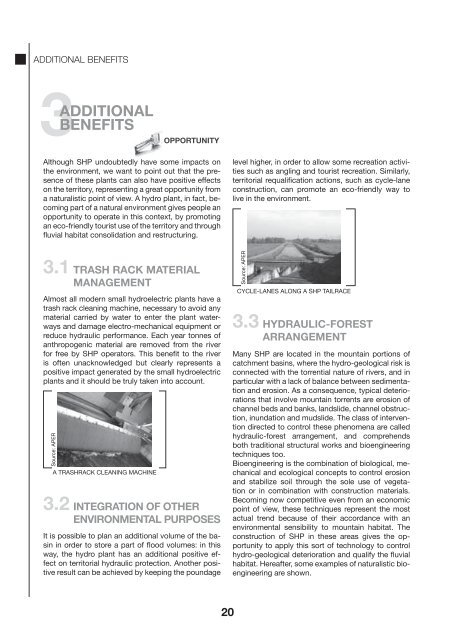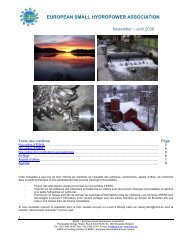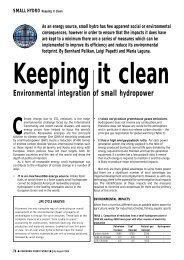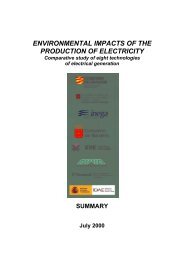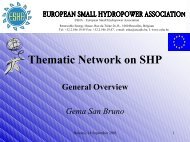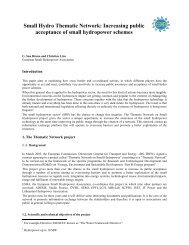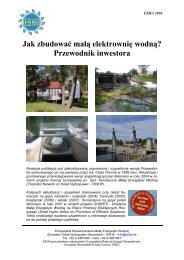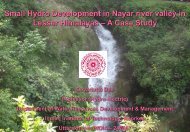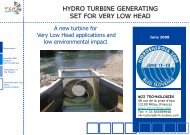HYDROPOWER AND ENVIRONMENT - ESHA
HYDROPOWER AND ENVIRONMENT - ESHA
HYDROPOWER AND ENVIRONMENT - ESHA
You also want an ePaper? Increase the reach of your titles
YUMPU automatically turns print PDFs into web optimized ePapers that Google loves.
ADDITIONAL BENEFITS<br />
3ADDITIONAL<br />
BENEFITS<br />
Although SHP undoubtedly have some impacts on<br />
the environment, we want to point out that the pre-<br />
sence of these plants can also have positive effects<br />
on the territory, representing a great opportunity from<br />
a naturalistic point of view. A hydro plant, in fact, becoming<br />
part of a natural environment gives people an<br />
opportunity to operate in this context, by promoting<br />
an eco-friendly tourist use of the territory and through<br />
fl uvial habitat consolidation and restructuring.<br />
3.1<br />
TRASH RACK MATERIAL<br />
MANAGEMENT<br />
Almost all modern small hydroelectric plants have a<br />
trash rack cleaning machine, necessary to avoid any<br />
material carried by water to enter the plant waterways<br />
and damage electro-mechanical equipment or<br />
reduce hydraulic performance. Each year tonnes of<br />
anthropogenic material are removed from the river<br />
for free by SHP operators. This benefi t to the river<br />
is often unacknowledged but clearly represents a<br />
positive impact generated by the small hydroelectric<br />
plants and it should be truly taken into account.<br />
Source: APER<br />
A TRASHRACK CLEANING MACHINE<br />
3.2<br />
OPPORTUNITY<br />
INTEGRATION OF OTHER<br />
<strong>ENVIRONMENT</strong>AL PURPOSES<br />
It is possible to plan an additional volume of the basin<br />
in order to store a part of fl ood volumes: in this<br />
way, the hydro plant has an additional positive effect<br />
on territorial hydraulic protection. Another positive<br />
result can be achieved by keeping the poundage<br />
20<br />
level higher, in order to allow some recreation activities<br />
such as angling and tourist recreation. Similarly,<br />
territorial requalifi cation actions, such as cycle-lane<br />
construction, can promote an eco-friendly way to<br />
live in the environment.<br />
Source: APER<br />
CYCLE-LANES ALONG A SHP TAILRACE<br />
3.3<br />
HYDRAULIC-FOREST<br />
ARRANGEMENT<br />
Many SHP are located in the mountain portions of<br />
catchment basins, where the hydro-geological risk is<br />
connected with the torrential nature of rivers, and in<br />
particular with a lack of balance between sedimentation<br />
and erosion. As a consequence, typical deteriorations<br />
that involve mountain torrents are erosion of<br />
channel beds and banks, landslide, channel obstruction,<br />
inundation and mudslide. The class of intervention<br />
directed to control these phenomena are called<br />
hydraulic-forest arrangement, and comprehends<br />
both traditional structural works and bioengineering<br />
techniques too.<br />
Bioengineering is the combination of biological, mechanical<br />
and ecological concepts to control erosion<br />
and stabilize soil through the sole use of vegetation<br />
or in combination with construction materials.<br />
Becoming now competitive even from an economic<br />
point of view, these techniques represent the most<br />
actual trend because of their accordance with an<br />
environmental sensibility to mountain habitat. The<br />
construction of SHP in these areas gives the opportunity<br />
to apply this sort of technology to control<br />
hydro-geological deterioration and qualify the fl uvial<br />
habitat. Hereafter, some examples of naturalistic bioengineering<br />
are shown.


